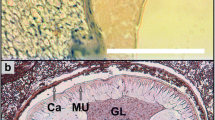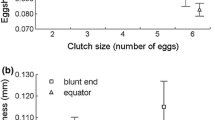Abstract
The concentration of Kepone in extruded egg masses and the backfin muscles of the blue crab,Callinectes sapidus, collected from seven stations in the lower James River and lower Chesapeake Bay was determined. Crabs from the lower James River were generally more contaminated than those from the lower Chesapeake Bay. Extruded eggs contain approximately three times more Kepone than backfin muscle. Egg extrusion is concluded to be a major route of Kepone clearance from female blue crabs.
Similar content being viewed by others
Literature Cited
Bahner, L. H., A. J. Wilson, J. M. Sheppard, L. R. Goodman, G. E. Walsh, andJ. M. Patrick, Jr. 1977. Kepone® bioconcentration, accumulation, loss, and transfer through estuarine food chains.Chesapeake Sci. 18:299–308.
Bender, M. E., R. J. Huggett, and W. J. Hargis, Jr. 1977. Kepone® residues in Chespeake Bay Biota, p. 14–37In Proceedings of the Kepone Seminar II, U.S. EPA, Region III, Philadelphia, Pa.
Bourquin, A. W., P. H. Pritchard, andW. R. Mahaffey. 1978. Effects of Kepone on estuarine microorganisms.Developments in Industrial Microbiology 19:489–497.
Butler, P. A. 1963. Pesticide-wildlife studies—A review of fish and wildlife service investigations during 1961 and 1962.United States Fish and Wildlife Circular 167, p. 11–25.
Costlow, J. D. 1977. Effects on insect growth regulators and juvenile hormone mimics on crustacean development. Quarterly Program Report to the Environmental Research Laboratory, United States Environmental Protection Agency, Gulf Breeze, Florida (unpublished progress report).
Hansen, D. J., L. R. Goodman, andA. J. Wilson. 1977a. Kepone® chronic effects on embryo, fry, juvenile, and adult sheepshead minnows (Cyprinodon variegatus).Chesapeake Sci. 18:227–232.
Hansen, D. J., D. W. R. Nimmo, S. C. Schimmel, G. E. Walsh, and A. J. Wilson. 1977b. Effects of Kepone on estuarine organisms, p. 20–30.In R. A. Tubb. (ed.), Recent Advances in Fish Toxicology: A Symposium. EPA Ecological Research Series EPA-600/3-77-085.
Hodgson, D. W., E. J. Kanter, andJ. B. Mann. 1978. Analytical methodology for the determination of Kepone residues in fish, shellfish, and Hi-vol air fillers.Arch. Environ. Contam. Toxicol. 7:99–112.
Metcalf, R. L. 1977. Biological fate and transformation of pollutants in water, p. 195–221.In I. H. Suffet (ed.), Fate of Pollutants in the Air and Water Environments. Pt. 2. Chemical and Biological Fate of Pollutants in the Environment. John Wiley and Sons, New York.
Moseman, R. F., H. L. Crist, T. R. Edgerton, andM. K. Ward. 1977. Electron capture gas chromatographic determination of Kepone® residues in environmental samples.Arch. Environ. Contam. Toxicol. 6:221–231.
Nimmo, D. W. R., L. H. Bahner, R. A. Rigby, J. M. Sheppard, and A. J. Wilson. 1977.Mysidopsis bahia: An estuarine species suitable for life-cycle toxicity tests to determine the effects of a pollutant.In F. L. Mayer and J. L. Hamelink (eds.), Aquatic Toxicology and Hazard Evaluation. ASTM STP 634, American Society for Testing and Materials, p. 109–116.
Provenzano, A. J., K. B. Schmitz, andM. A. Boston. 1978. Survival, duration of larval stages, and size of post-larvae of grass shrimp,Palaemonetes pugio, reared from Kepone® contaminated and uncontaminated populations in Chesapeake Bay.Estuaries 1:239–244.
Ricker, W. E. 1973. Linear regressions in fishery research.J. Fish. Res. Board Can. 30:409–434.
Rubinstein, N. I. 1979. A benthic bioassay using time-lapse photography to measure the effect of toxicants on the feeding behavior of lugworms (Polychaeta: Arenicolidae).In W. B. and J. F. Vernberg (eds.), Marine Pollution: Functional Responses. Academic Press.
Schimmel, S. C., J. M. Patrick, Jr.L. F. Faas, J. L. Oglesby, andA. J. Wilson, Jr. 1979. Kepone® Toxicity to and bioaccumulation by blue crabs.Estuaries 2:8–14.
—, andA. J. Wilson. 1977. Acute toxicity of Kepone® to four estuarine animals.Chesapeake Sci. 18(2):224–227.
Steele, R. G. D., andJ. H. Torrie. 1960. Principles and Procedures of Statistics. McGraw-Hill Book Co., Inc., New York. 481 p.
Tukey, J. W. 1977. Exploratory Data Analysis. Addison-Wesley Publishing Company, Massachusetts, 688 p.
Walsh, G. E., K. Ainsworth, andA. J. Wilson, Jr. 1977. Toxicity and uptake of Kepone in marine unicellular algae.Chesapeake Sci. 18:222–223.
Author information
Authors and Affiliations
Additional information
Contribution No. 956 from the Virginia Institute of Marine Science, Gloucester Point, Virginia 23062.
Rights and permissions
About this article
Cite this article
Roberts, M.H., Leggett, A.T. Egg extrusion as a kepone-clearance route in the blue crab,Callinectes sapidus . Estuaries 3, 192–199 (1980). https://doi.org/10.2307/1352069
Issue Date:
DOI: https://doi.org/10.2307/1352069




